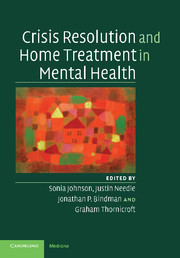Book contents
- Frontmatter
- Contents
- List of contributors
- Foreword
- Acknowledgements
- Section 1 Introduction and concepts
- 1 Introduction
- 2 The development of crisis resolution and home treatment teams
- 3 The crisis resolution team model: recent developments and dissemination
- Section 2 The evidence
- Section 3 Current practice
- Section 4 Variations and enhancements
- Section 5 Developing a local service
- Index
- References
1 - Introduction
from Section 1 - Introduction and concepts
Published online by Cambridge University Press: 13 August 2009
- Frontmatter
- Contents
- List of contributors
- Foreword
- Acknowledgements
- Section 1 Introduction and concepts
- 1 Introduction
- 2 The development of crisis resolution and home treatment teams
- 3 The crisis resolution team model: recent developments and dissemination
- Section 2 The evidence
- Section 3 Current practice
- Section 4 Variations and enhancements
- Section 5 Developing a local service
- Index
- References
Summary
Crisis resolution teams (CRTs) have risen rapidly to prominence in the UK since the mid 1990s. We will go into a good deal more detail about the characteristics of these teams in subsequent chapters, especially Chapter 6, but it is probably helpful to begin with a working definition. As currently used, the term CRT is applied to specialist multidisciplinary teams that aim to:
assess all patients being considered for admission to acute psychiatric wards
initiate a programme of home treatment with frequent visits (usually at least daily) for all patients for whom this appears a feasible alternative to hospital treatment
continue home treatment until the crisis has resolved and then transfer patients to other services for any further care they may need
facilitate early discharge from acute wards by transferring inpatients to intensive home treatment.
A note on terminology: crisis resolution team, crisis assessment and treatment team and intensive home treatment team are currently used roughly synonymously in the UK. Crisis intervention team is an older term, which originally referred to services that applied crisis intervention theory to a broad range of psychosocial crises, not only those in which admission seemed imminent (Chapter 2). In the UK, the primary care physician is the general practitioner (GP), and the UK term will be used for this role throughout the book.
Prior to 2001, only a small handful of UK centres had CRTs, generally inspired by Australian models.
- Type
- Chapter
- Information
- Publisher: Cambridge University PressPrint publication year: 2008



